Note: This website was automatically translated, so some terms or nuances may not be completely accurate.
OOH Can Succeed Even During the Pandemic!
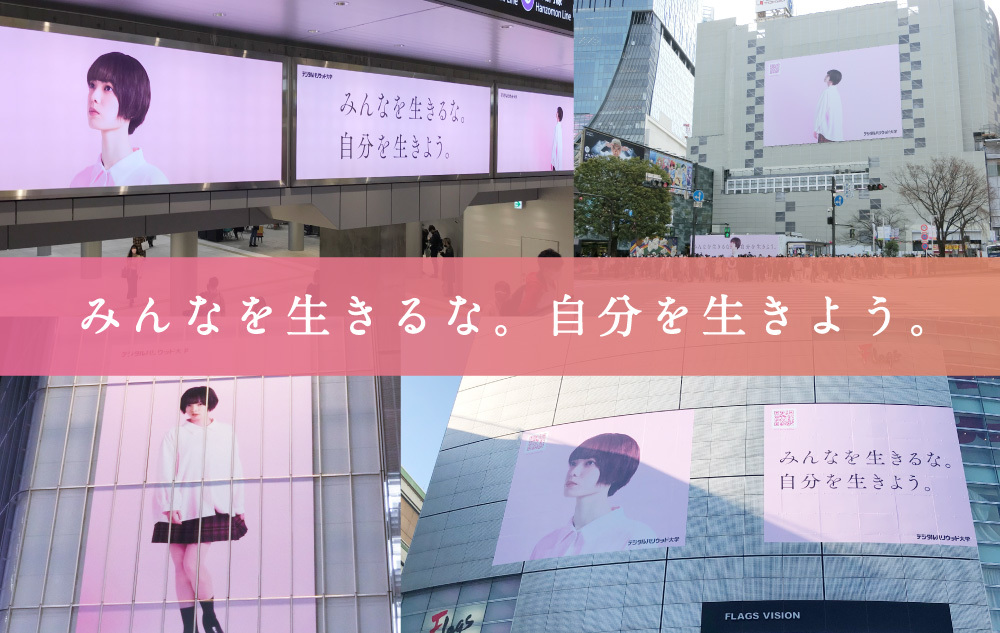
In March 2021, Digital Hollywood University launched a large-scale OOH (Out Of Home: outdoor advertising) campaign in Shibuya and Shinjuku.
Spring-themed graphics featuring Yurina Hirate appeared on Shibuya's Hachiko Big Sheet Final (*1), Shibuya Kenjo Sheet (*2), and QFRONT Q's Wall (*3). This generated significant buzz on TV and social media.
Amidst declining OOH advertising spending due to the pandemic, we asked Ryuzo Yamamoto, Executive Officer and Head of the Public Relations Office at Digital Hollywood Inc. (Note 4), about the reasons behind this large-scale OOH campaign.
*1 Hachiko Big Sheet Final: A massive sheet advertisement measuring 25.4m wide × 17.0m high, utilizing the wall of the former Tokyu Department Store Tokyu Toyoko Store building. It possesses an overwhelming presence.
※2 Shibuya Charter Sheet: A sheet advertisement installed at Hachiko Square, Shibuya Station West Exit. It frequently appears as a background in TV programs and other media, making it highly visible.
※3 QFRONT Q'sWall: A sheet advertisement displayed on the exterior wall of the landmark QFRONT Building at Shibuya Scramble Crossing.
※4 Digital Hollywood Co., Ltd.: Operates multiple educational initiatives, including Digital Hollywood University, fostering skills and capabilities for the digital society.
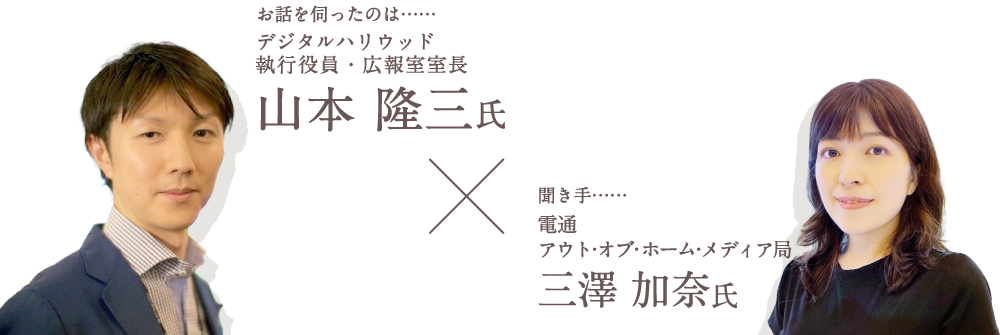
Elevate brand image with a simple tagline that captures the essence
──First, could you explain the purpose and objectives of this campaign?
We launched this campaign because we wanted to change the positioning of Digital Hollywood University, and by extension, the entire group, including our graduate school and adult education programs. Among university applicants, the university's catchy name often led to issues like it being jokingly listed as a preferred school on practice exam forms, preventing people from seeing its true essence. It's undesirable for that applicant generation to associate that image with us when they later consider studying digital creativity.
Therefore, starting in 2017, we began brand communication to convey who we truly are to the world. Our tagline, "Don't live for others. Live for yourself," embodies our wish for high school students preparing for university to consider their own unique paths and navigate the changing times. We've used this tagline consistently for four years, delivering a simple message that conveys our university's philosophy and values through a combination of OOH, TV commercials, and digital advertising every year.
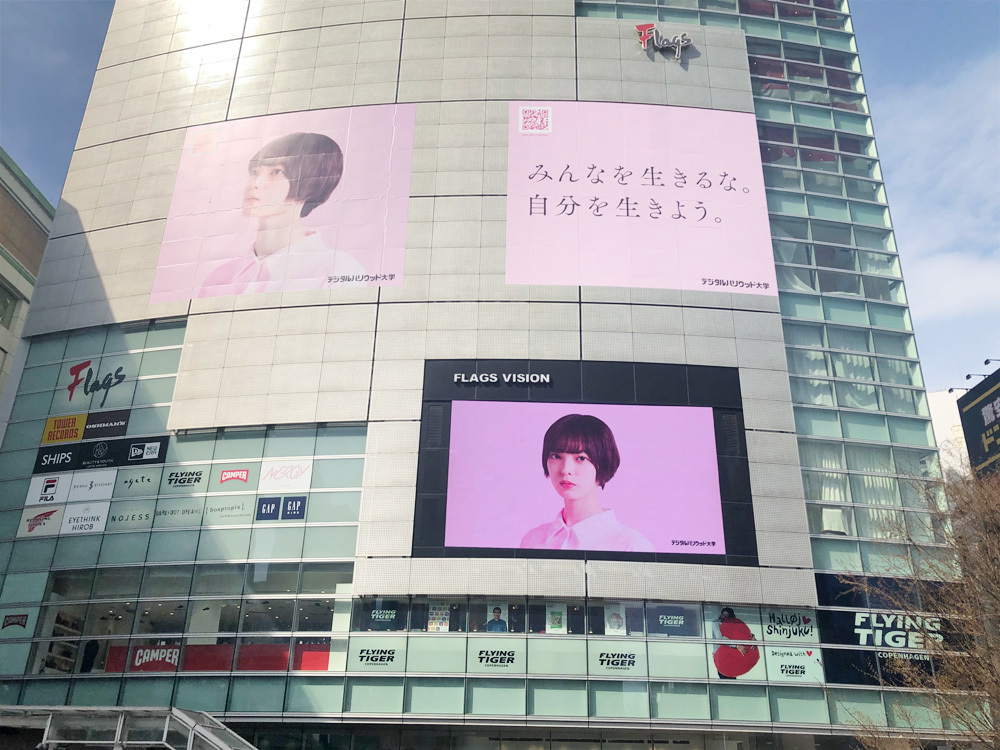
──The ad doesn't prominently feature the university logo and contains no information beyond the tagline. Did that concern you during placement?
I believe a beautiful visual and a simple tagline were sufficient to convey the message: "Leverage your unique strengths and live authentically." The "product" we handle—the university—isn't something people will remember from an ad and immediately go buy at a convenience store, no matter how many "product features" we list. Therefore, we believe it's essential to appeal to the core.
Others often suggest we should emphasize achievements, like "a university that produces many startups." However, that's information interested high school students would want when visiting an open campus, not something they seek after casually encountering an OOH ad or commercial. Such details are available on our website. We consciously divided roles: preparing linked graphics and copy to capture traffic from OOH ads.
How do high school students perceive the world today? The rigid entrance exam system and the outdated notion that attending a university with even slightly higher academic rankings is better feel stifling, even to adults. We infused the ad with the wish that students would choose their next educational path as a place where they can actively engage in areas that interest them and gain valuable experience.
Achieved reach beyond expectations. It became a hot topic not only among exam takers but also among parents, alumni, and employees!
──Why did you choose OOH advertising? What role did you expect OOH to play?
We considered how to make the ad a talking point within a limited budget. Advertising has become challenging in this era. We live in an age of information overload. Compared to my childhood, people can now watch their favorite commercials on YouTube, so the relative value of content has decreased. It's better for the message to spread through acquaintances than for the ad to be the first point of contact. Therefore, we decided on OOH placement in Shibuya, a location frequented by our target high school students and often featured on TV.
In previous years, we placed OOH graphics linked to the commercial airing at several locations immediately after the broadcast. However, this year, the third wave of COVID-19 hit around the time of the airing, and the situation changed daily with the declaration of a state of emergency. Precisely because of these times, we began exploring additional communication methods. We redesigned the campaign, focusing primarily on OOH, targeting students facing uncertain environments as they prepared for high school entrance exams or grade advancement. We learned that popular OOH spots in central Tokyo had become available due to reduced foot traffic during the state of emergency. Additionally, we heard that a new, large-scale spot—the largest in Japan—was planned for the building wall of the former Tokyu Department Store Tokyu Toyoko branch in Shibuya. This led us to decide on a large-scale OOH campaign.
The media proposed by Dentsu Inc. included large spaces in Shinjuku and Shibuya, digital signage centered on Shibuya, and the "Youth Board" (outdoor advertising targeting high school students in the Tokyo metropolitan area), which covers media near high schools' nearest stations and along commuting routes. Internally, there were opinions questioning whether advertising only in the Tokyo metropolitan area was sufficient. However, we concluded that to create a state where people react with "Wow, what is that? It really catches your eye," we needed to concentrate our limited resources intensively. This led us to finalize this plan.
──How was the actual response to the campaign?
We were fortunate that everything we envisioned came to fruition. There were three main benefits to running this OOH campaign.
First, we reached a wider audience than anticipated based on the ad spend. The location in front of the Scramble Crossing drew such large crowds that it surpassed major key stations in Shibuya, and it was featured extensively in the news. This time, we placed OOH ads on a larger scale than ever before, but since it was a period when people were being asked to refrain from going out, we didn't release a campaign announcement.
However, among Yurina Hirate's fans, word spread that "such a large ad is up," and they enthusiastically posted about it on social media. So later, we publicly shared the locations in Shinjuku and Shibuya online. We even heard comments like "I wanted to travel all the way to Tokyo to see it," and fans in the greater Tokyo area had exchanges like "Well, I'll take a photo and post it." I remember feeling happy realizing that for the fans, it was something to celebrate.
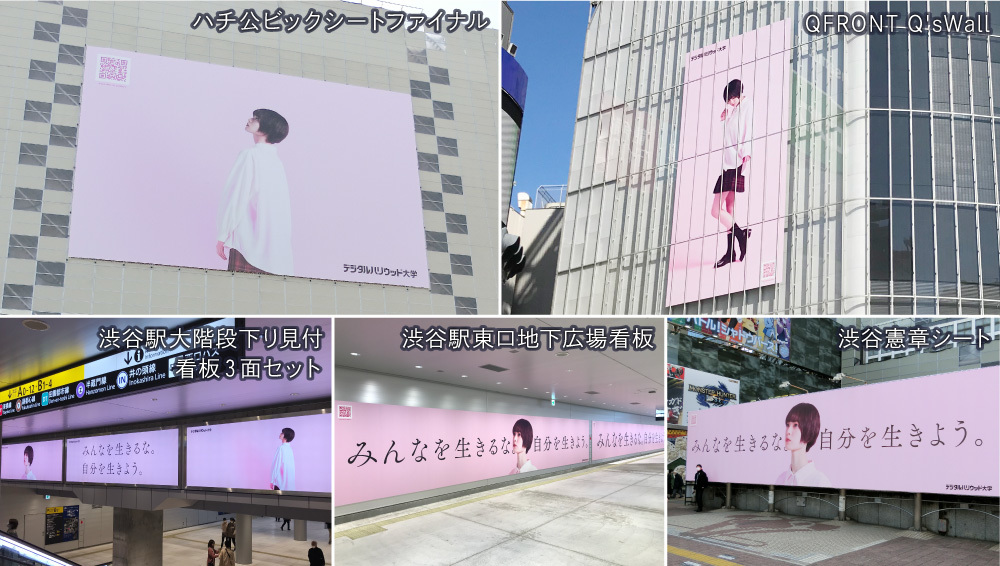
The "Youth Boards" were great because they sparked reactions like, "Hey, there's one in my hometown!" and created multi-layered communication. Since they aren't too expensive, they're a good medium to combine with other ads. I don't think this campaign would have generated this much buzz if we'd only used the Shibuya station media. Similarly, if we'd just aired the TV commercial or spent the same budget on digital ads, we wouldn't have achieved this effect.
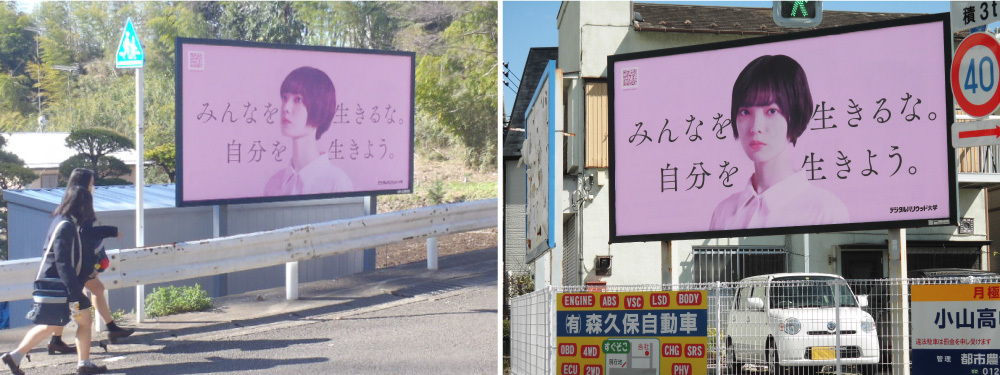
Second, the university became a topic of conversation among the target audience and their social circles.
While not quantifiable, seeing mothers of high school students enthusiastically taking photos made me happy, realizing we could reach that generation too. The generation familiar with computers is now becoming parents. Compared to before, I feel understanding of digital creative is spreading among parents, making outreach to this generation important. Additionally, it was an unexpected delight that our alumni started talking about the university after seeing the OOH ads.
High school students are greatly influenced by the adults around them. When parents and alumni perceive the ads positively and actively share them, it becomes a major catalyst for students to consider our university.
Third is improved engagement. I'm also involved in recruitment, and employee motivation has skyrocketed. Our company has about 20 licensed school locations nationwide. It was incredibly beneficial for the company to unite everyone—including those working in areas like Kyushu and Tohoku, employees, and operational staff—under a shared sense of purpose: "This is the kind of school we're running," and "This is the kind of brand we're working for." With remote work, there's a tendency for a sense of belonging to the company to weaken. OOH is also effective in boosting employee engagement.
──Based on these results, how do you plan to utilize OOH moving forward?
We've seen that even a small company like ours can generate significant response. Moving forward, we want to continue developing communications that deliver positive surprises and delight. While the specific projects and talent assignments may change each time, the creative directors we collaborate with deeply commit to our university and company's philosophy, translating it into language and visuals. Therefore, we want to maintain the core concept. Societal moods, media landscapes, and ad tech will continue evolving. Within that, we want to focus on how to express universal essence and when to communicate it.
After the interview...
This spring, while walking through Shibuya Station, I encountered two high school girls taking photos of this campaign's OOH advertisement. The large cherry blossom-colored graphic stood out remarkably, brightening my own mood as I passed by.
While OOH is often called buzz media, not everything becomes a topic of conversation. I believe the Digital Hollywood University campaign succeeded because it skillfully captured the zeitgeist. It effectively communicated a simple yet powerful message that resonated with high school students facing future anxieties, conveying a positive outlook through vacant OOH media spaces.
The so-called "with-corona" state is becoming prolonged. Even under emergency declarations, some people must go out for commuting or attending school. Integrating into the urban landscape is a unique strength of OOH, so I hope advertisers will effectively utilize it for their brand communication.
Was this article helpful?
Newsletter registration is here
We select and publish important news every day
For inquiries about this article
Back Numbers
Author

Kana Misawa
Dentsu Inc.
Out-of-Home Media Division
After working in creative, sports business, AI chatbot, and healthcare business development, he assumed his current position. He is involved in developing media planning tools centered on OOH and business development in the data and technology domain. Ph.D. (Interdisciplinary Information Studies)


